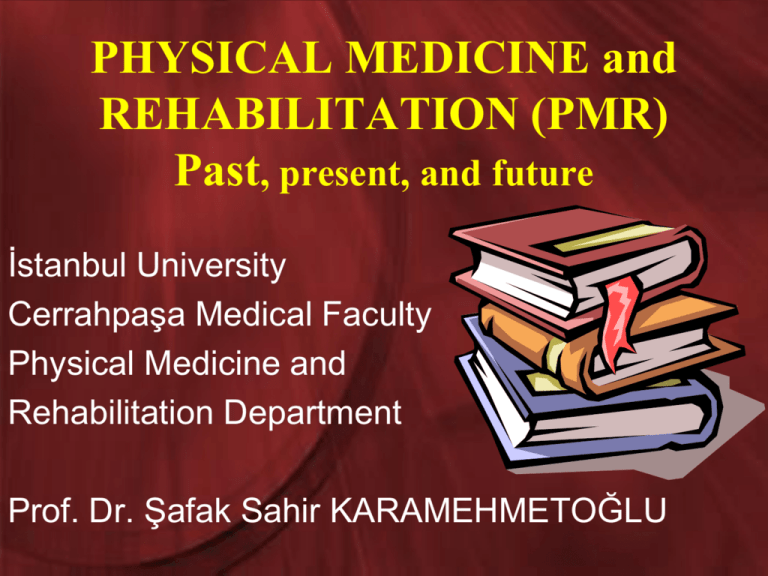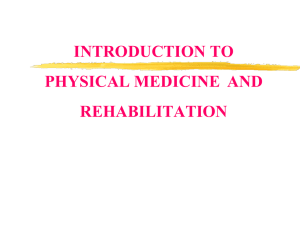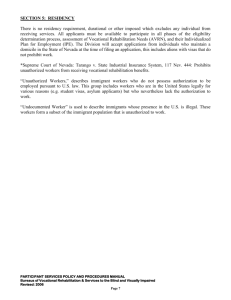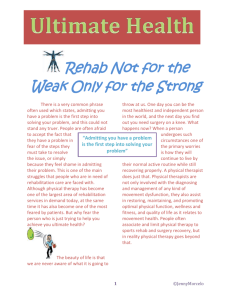rehabilitation
advertisement

PHYSICAL MEDICINE and REHABILITATION (PMR) Past, present, and future İstanbul University Cerrahpaşa Medical Faculty Physical Medicine and Rehabilitation Department Prof. Dr. Şafak Sahir KARAMEHMETOĞLU HEALTH WHO’s definition: Physical, psychological and socially complete well-being. IMPAIRMENT Definition: Any loss or abnormality of psychological, physiological, or anatomical structure or function. IMPAIRMENT Impairment includes clinical features or manifestations of the disease or condition. Examples: weakness, limited ROM, confusion etc. In this definition function is the function of a body part, not the whole-person function. DISABILITY Any restriction or lack resulting from impairment of ability to perform an activity in the manner or within the range considered normal for a human being. HANDICAP A disadvantage for a given individual resulting from an impairment or a disability that limits or prevents the fulfillment of a role that is normal (depending on the age, gender, social and cultural factors) for that individual. WHO DEFINITIONS Impairment ↔ Organ or Tissue Disability ↔ Whole Person Handicap ↔ Society PHYSICAL MEDICINE • Physical medicine is the use of physical methods and agents in the diagnosis and treatment of the disease, impairment, disability and handicap PHYSICAL THERAPY • Physical therapy is the use of physical methods and agents in the treatment of the disease, impairment, disability and handicap MEDICINE • Preventive • Medical (surgical) • Rehabilitation Conventional Medicine • Concerned with diagnosis, • Tends to curable diseases. REHABILITATION • Diagnosis is not mandatory • Concerned with functional problems REHABILITATION Rehabilitation is the process of helping a person to reach the fullest physical, psychological, social, vocational, avocational, and educational potential consistent with his or her physiologic or anatomical impairment, environmental limitations, and desires and life plans. CLASSIFICATION OF DISABILITY AND HANDICAP 1. Orthopedic 2. Visual 3. Mental 4. Hearing 5. Speech 6. Mixt 7. Others → → → → → → → Physical Blind Psy Deaf PHASES OF REHABILITATION 1. Medical Rehabilitation 2. Vocational Rehabilition 3. Economical Rehabilitation 4. Social rehabilitation REHABILITATION TEAM-1 - Physiatrist - Physiotherapist - Rehabilitation nurse - Therapist - Occupational therapist - Social worker REHABILITATION TEAM-2 - Speech therapist - Psychologist - Orthotist-Prosthetist - Vocational councellor - Others (doctors, etc) PHYSIATRIST • • • • • • • • • Leader of the team. Responsible for each intervention Evaluates the patient Plans. Organizes. Directs Coordinates. Controls. Motivates. NURSE • • • • • • Controls environmental factors. Directs personal care of the patient. Manages medication. Is responsible for skin integrity. Helps ADL and adaptive devices. Organizes bowel and bladder program. • Helps the patient manage their time. • Informs the team about the status of the patient • Educates the patient and the family PHYSIOTHERAPIST • Performs muscle strength testing. • Evaluates th length and the tonus of the muscle • Exercises the patient especially for gross motor function. • Teaches how to transfer. • Instructs the use of wheelchair, canes and crutches. • Offers physical therapy modalities. • Educates for posture and walking. THERAPIST • Performs some physical therapies such as: 1. Electrotherapy 2. Superficial heat (IR, HP, Paraffin) 3. Deep heat (UST, SWD, MWD) 4. Traction 5. Massage Occupational therapist • ADL. • Trains the patient in the functional use of upper extremities. • Explores the vocational skills. • Evaluates the home and suggest modifications. • Trains patients in the use of assistive technology. • Collaborates with all of the team Orthotist - Prosthetist • Evaluation • Design • Fabrication of orthosis (braces) and/or prosthesis (artificial limb) • Follow-up • Instructs the patients and the family the use and the maintenance of these devices • Collaborates with all of the team Speech Therapist • Evaluates patients with aphasia, dysarthria, apraxia • Speech, comprehension, reading and writing • Swallowing, feeding • Other communicative problems and proper therapies • High technologies • Family and patient education and counseling Psychologist • Evaluates the psychological status of the patients • Tests intelligence, memory and perceptual functioning • Incorporates the test results into the care plan • Educates family and patient • Counseling of the family Social worker • Evaluates patients (life-style, family, finances, employment, environmental factors) • Maintains a continuing relationship with the patient and family • Coordinates funding resources • Provides assistance in locating alternative living situations • Assess vocational barriers • Provide emotional support in strressful situations • Facilitates discharge planning Vocational Councellor • Assists in developing and attaining realistic vocational goals • Evaluates vocational interests, aptitudes, and skills • Councels patients in the work environment • Organizes activities to develop employer-employee relationship behaviors • Acts as a liaison between the patient and agencies that provide training or job placement services • Provides counceling, education, and support to potential employers (job analysis on worksite) Other Rehabilitation Professionals • • • • • • • • • • • • • • • • • • Audiologist Bioengineer Child life specialist Dance therapist Dentist Dietitian Durable medical equipment vendor Enterostomal therapist Hippotherapist Horticultural therapist Hospital-based school teacher Hydrotherapist Kinesiotherapist Maxillofacial prosthetist Music therapist Podiatrist Recreational therapist Others LOCOMOTOR SYSTEM • Rheumatic • Traumatic & orthopedic • Neurologic Some of the conditions in the land of PMR • • • • • • • • • • • • • • • • • • • • • • Disc herniations Osteoarthritis Osteoporosis Soft Tissue Rheumatisms Ankylosing Spondylitis Rheumatoid Arthritis Chronic Pain Temporomandibular Disfunction Neck Pain Back Pain Low-back pain Upper limb pain Lower limb pain Metabolic bone disease Metabolic joint disease Myofascial Pain Peripheral Vascular Diseases Cummulative Trauma Disorders Hemiplegia Traumatic Brain Injury Spinal Cord Injury Peripheral Nerve Injuy • • • • • • • • • • • • • • • • • • • • • • • Muscular Dystrophies Multiple Sclerosis Traumatic Locomotor System Diseases Vestibular Rehabilitation Rehabilitation after arthraoplasties Parkinson Disease Scoliosis Spasticity Pressure Sores Amputee Rehabilitation Hand Rehabilitation Sports Injury Rehabilitation Cerebral Palsy Poliomyelitis Postpolio Syndrome Guillain Barre Syndrome Cardiac Rehabilitation Pulmonary Rehabilitation Pediatric Rehabilitation Geriatric Rehabilitation Bladder and bowel management Others Clinical Evaluation • • • • Detailed History of the Patient Physical Examination Evaluation of Function PMR Diagnosis Disease Impairment Disability Handicap Demographic Data • Name - surname: • Age: • Gender: • Profession: • Place of birth: • Marital status: History & Physical Examination • Direct from the patient • From the family, relatives, friends, caregivers, attendants, nurses, doctors, health agency, reports, others Complaint(s) • Main complaint(s) (pain, weakness etc.) • Others (vertigo, vomiting etc.) History-1 • • • • • • Date of onset Any cause Character and severity Time relationship Location and extension Associated complaints History-2 • • • • • Aggravating factors Alleviating factors Previous treatments and effects Progress Remissions and exacerbations History-3 • • • • Previous diseases Coexisting diseases Surgical interventions Trauma History-4 • • • • Alerjy Delivery, menses, menaupose Smoking, alcohol and drug Social status Family History • Illness in the family • Cause of deaths General health state • • • • • • Fever Blood pressure Pulse rate Body structure Color changes Edema Examination of locomotor and neurologic system • • • • • • • Inspection Palpation & pression ROM Sensation DTR Muscle testing Special tests Skin & mucosal examination • • • • • • Pressure sores Infection Maceration Ulceration Pigmentation Hair loss Ear-nose-throat • • • • • • • Whispering test Audiogram Otoscopic examination Teeth repair Gingivitis TMJD Poor nutrition Respiratory system • • • • • Inspection Auscultation Palpation Percussion Respiratory tests Cardio-vascular system • • • • • • Auscultation Palpation DVT Varices Raynaud phenomenon Doppler Gastro-intestinal system • • • • Inspection Auscultation Palpation Percussion Urogenital system • • • • • • • • Incontinence Maceration Ulceration Urinary retention Residual urine Orchitis Epididimitis Penile fistulas Communication • Listening • Reading • Speaking • Writing • • • • • • Do you have difficulty hearing? Do you use a hearing aid? Do you have difficulty reading? Do you need glass to read? Do others find it hard to understand what you say? Do you have difficulty putting your thoughts into words? • Do you have difficulty finding words? • Can you write? • Do you use any communication aids? Eating • Can you eat without help? • Do you have difficulty opening containers or pouing liquids? • Can you cut meat? • Do you have difficulty handling a fork, knife or spoon? • Do you have problems bringing food or beverages to your mouth? • Do you have problems chewing? • Do you have difficulty swallowing solids or liquids? • Do you ever choke? • Do you regurgitate food or liquids through your nose? Grooming • Can you brush your teeth without help? • Can you remove and replace your dentures without help? • Do you have problems fixing and combing your hair? • Can you apply your make-up independently? • Do you have difficulty shaving? • Can you apply deodorant without assistance? Bathing • • • • Can you take a tub or shower without help? Do you feel safe in the tub or shower? Do you use a bath bench or a shower chair? Can you accomplish a sponge bath independently? • Are there parts of your body you can not reach? Toileting • Can you use the toilet without help? • Do you need help with clothing before and aftr using a the toilet? • Do you need help wih cleaning after a bowel management Dressing • Do you dress daily? • What articles of dressing do you regularky wear? • Do you need assistance putting on or taking off your underwear, shirt, slacks, skirt, dress, coat, stockings, panty hose, shoes, tie, etc.? • Do you need help with buttons, zippers, hooks or shoelaces? • Do you need clothing modifications? Bed Activities • Can you turn onto your front, back, and sides without assistance? • Can you lift your hips off the bed when supine? • Do you need assistance to sit or lie down?. • Do you have difficulty maintaining a seated position? • Can you operate the bed controls on an electric hospital bed? Transfers • Can you move between the bed, toilet, bath bench, shower chair, standart seating, or car seat and the wheelchair without help? • Can you get out of bed without difficulty? • Do you need assistance to stand from low or high seats? • Can you get on and off the toilet without help? Wheelchair Mobility • Do you propel a weelchair? • Do you need help to lock the wheelchair brakes before transfers? • Do you need assistance to cross high-pile carpets, rough ground, or inclines? • How far and how many minutes can you wheel before you need rest? • Can you independently move about your living room, bedroom, and kitchen? • Do you go shopping, restaurants, and friends’ home Ambulation • Do you walk unaided? • Do you use a cane, crutches, or a walker to walk? • How far and how many minutes can you walk before you must rest? • What stops you from getting further? • Do you feel unsteady or do you fall? • Can you go upstairs and downstairs unassisted • Do you go shopping, restaurants, and friends’ home? • Can you use public transportations without help Operation of a motor vehicle • Do you have a valid driver’s licence? • Do you own a car? • Do you drive your car to go shopping, restaurants, and friends’ home? • Do you drive in heavy traffic or over long distances? • Do you use hand controls or other automobile modifications? • Have you experienced any motor vehicle accidents or received any citations for improper operation of a motor vehicle since your illness or injury? Laboratory • RBC, WBC, Hct • Sedimentation rate • Urinary analysis Rx, CT, MRI, scintigraphy and other advanced technics Therapy and/or rehabilitation








